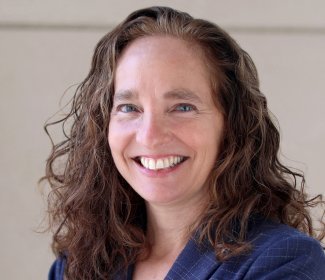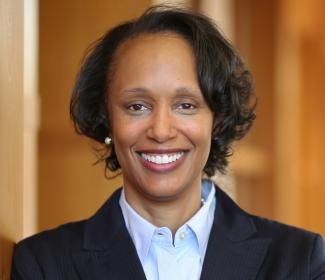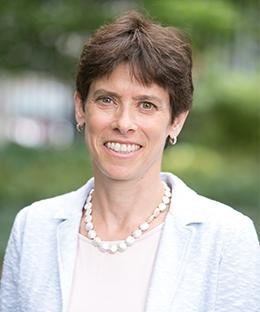The Title IX 50th Anniversary Symposium
Holly Chaisson ‘23
Guest Writer
Pictured, from left to right: Dean Goluboff, Professor Kimberley Robinson, Deputy Assistant Secretary Goldberg, Professor Emily Suski
Friday’s symposium was the result of five months of planning by student organizations to celebrate the 50th Anniversary of Title IX. Prior to the opening remarks, the law student organizers set the mood with a curated Spotify playlist, kicking things off with Ariana Grande’s “God is a Woman.” Dean Goluboff then welcomed attendees and spoke of her personal connections to Title IX—first, her breaking of gender barriers in becoming the first female dean of the Law School, and second, her participation on the boys’ wrestling team in junior high—feats Title IX paved the way for in her own life. The dean concluded her remarks by highlighting the theme of the symposium: though Title IX has done tremendous work in the fifty years since its enactment, its work is far from over. As many of the panelists would later explain, it is not the case that Title IX’s regulations have benefited equally those it aims to protect.
Professor Kimberley Robinson took the podium next and, like Dean Goluboff, acknowledged that she herself was a product of Title IX and would not be here at the Law School without it. Tracing the progress of Title IX, Professor Robinson reminded attendees that in public school, prior to Title IX, women and girls were taught how to be in the home and presented with essentially three career options: teacher, nurse, or secretary (a position notably not open to Professor Robinson’s own mother due to segregation). Today, this is no longer the case, and while data from a Stanford study shows that Title IX has closed the gender achievement gap in many ways in K-12 schools, there are still gender differences that endure and disadvantage girls.[1] Data tracing teachers’ attitudes show that they believe girls need to work harder in math to achieve, an attitude that affects how they treat girls in the classroom despite the data also showing there is no gender achievement gap in math for students in 3rd–8th grade math. Parents’ attitudes have an impact as well, and data reveal they think of boys as more likely to be gifted than girls. And while Title IX has greatly expanded access to higher education for women, gender disparities still persist, especially in the STEM fields and in attainment of post-graduate degrees. Professor Robinson concluded her remarks by noting improvement is still much needed in the area of high school sports, pointing out that the number of girls participating in sports has still not caught up to the number of boys in high school sports as it existed in 1972. And women are still fairly underrepresented in college sports based on how much of the student body they make up.
The first panel of the day was on the topic of sexual violence and abuses of power in higher education. The panelists discussed factors contributing to gender-based violence on campuses and how Title IX combats this, highlighting the major roles that a lack of comprehensive sex education (including education with respect to the concept of consent) and the pervasive culture of victim-blaming play. A recurring theme during the panel was the disproportionate impacts Title IX had based on factors including race, gender, social status (e.g., member of a fraternity, athlete), and socio-economic status. Unsurprisingly, students who are members of marginalized communities often are most impacted, with complainants finding less success or even being discouraged from bringing their claims in the first place and marginalized perpetrators being found guilty and punished more harshly than their privileged counterparts. When asked how to reform the Title IX adjudicative process to address these disparities, the panelists focused on the role of transformative justice. Lexi Weyrick, a law clerk at Van Dermyden Makus Law Corporation, spoke about how transformative justice would remove the institutional actor and put power back in the hands of the complainants, allowing them to guide the process and address the root of the harm in an effort to prevent future harm from occurring. Her co-panelist Dena Robinson, a trial attorney with the DOJ’s Civil Rights and Employment Discrimination Division, agreed, highlighting the need to ask survivors in particular what they want from the process and the importance of making it so the perpetrator recognizes the harm they’ve caused to prevent future harm, something punishment alone can’t always accomplish.
The second panel focused on access to sports for transgender students, a particularly salient topic for the symposium given that this is a time when transgender and gender non-conforming students are being attacked across the country via state legislative efforts.[2] The panel featured Lindsay Hecox, a student at Boise State University who, alongside the ACLU, is currently challenging a law in Idaho (HB 500) which bans women and girls who are transgender and many who are intersex from participating in sports. The panelists discussed how access to sports for transgender students has indeed made progress in recent decades and that having the friendly Biden administration in office is facilitating more inclusive paths to sports for transgender students. Speaking about the recent bans on transgender students in sports, Ritchie Eppink, a lawyer for the ACLU of Idaho, said these cases are furthering the medicalization of who gets dignity and humanity and that lawyers and advocates fighting these cases need to include the people who don’t have “off-switches” (i.e., trans and gender non-conforming people) in the room when deciding tactics to educate and fight back.
The panel also highlighted the particular issues that arise for K-12 transgender students under Title IX. According to Emily Suski, a professor at the University of South Carolina School of Law, K-12 students suffer more sexual harassment than students in higher education, yet courts do not treat their claims commensurate with the problem and give the latter more protection than the former. Further, the majority of sexual harassment in K-12 public schools is directed toward the LGBTQIA+ community. Lindsay herself testified that the thought of facing potential discrimination in high school led her to make the decision to present as her gender assigned at birth until she reached college. The panel touched briefly on the current debate surrounding the participation of transgender women in sports as it relates back to Title IX. Civil rights attorney Ezra Young pointed out that the higher purpose behind Title IX is achieving gender equality in sports and closing any gaps and that those who are hung up on whether or not trans women are winning more medals than cis women are missing the point if these funding and opportunity disparities still exist. And Professor Erin Buzuvis noted that the argument that the exclusion of trans girls is to protect them fails because it actually harms them by reinforcing the false trope that women are categorically athletically inferior—it is simply not the case that all boys are better than all girls at sports. Lindsay closed out these remarks by reflecting on her personal experience as a trans athlete and made the point that most politicians in these arguments forget that most athletes—in her experience—are not comparing themselves to others, but are focused on doing the best they can for themselves, a truth bolstered by her experience coaching high school track and watching the athletes be focused simply on enjoying the sport and the journey.
The third panel focused on the intersection between access to contraception and gender equality. Both panelists emphasized that while Title IX and reproductive rights don’t always work together, access to contraception is required for true gender equality. Maha Ibrahim emphasized that it is a legal fiction that everyone enters into their educations equal to begin with, because a lack of access to contraception and abortion services on campus is part of the embedded inequity that exists for those assigned female at birth. The bodily autonomy facilitated by access to contraception is also an issue not just for people who can get pregnant, but for anyone engaging in sexual activity (noting that access to contraception includes access to condoms, vasectomies, etc.). Given the myriad barriers posed to access to contraception on campuses, reform in this area is crucial to further the purpose of Title IX in higher education.
The final panel concerned the intersectional failings of Title IX throughout its fifty-year life span thus far. The panelists acknowledged Title IX’s failings with respect to race and suggested turning to critical race feminism as a starting point in moving toward racial justice in this arena. One step schools could take, according to panelists, would be to offer intersectional resources and processes that took into account the multifaceted-ness of student identities rather than ignoring the role identities play in these processes. In implementing Title IX, schools need to examine their processes and ask probing questions like, “Who is it that the school has in mind when they are thinking of a complainant/survivor?” to get at potential issues. For example, if a Title IX office is located in a school’s “Women’s Center,” it indicates a school may be expecting only complainants/survivors who are women, and may unconsciously alienate cisgender men and transgender and gender non-conforming individuals as a result. And because Title IX’s mandate against harassment based on sex includes sexual orientation and gender identity, schools are going to need to continually reevaluate their procedures as the enforcers of Title IX to ensure this mandate is carried out.
Finally, Suzanne Goldberg’s keynote address took the audience on a tour through Title IX’s history and what she imagines as its future. She emphasized that Title IX has gained significant meaning over time as the case law and regulations interpreting it have grown, shaping Title IX throughout its lifetime. Social movements, especially those driven by students, can have a significant impact on the shape of Title IX in the future, and Goldberg urged the students in attendance to reflect on the ways they advocate in relation to Title IX and what they may go on to do in that respect in their careers. Goldberg also highlighted the progress made by the Biden administration (of which she is a part as the Deputy Assistant Secretary for Strategic Operations and Outreach at the Department of Education’s Office for Civil Rights). Recent executive orders are examples of efforts to employ Title IX to address racial injustice in an effort to achieve broader equity and to combat discrimination based on sexual orientation and gender identity, a critical step forward in a post-Bostock world.
While the symposium clearly highlighted the failings of Title IX over its half-century existence, it equally showcased its successes and carved out ways for its purpose to be advanced further, a task well-suited for the Law School’s graduates.
---
hmc5wn@virginia.edu
[1] Professor Robinson acknowledged that she was using a binary concept of gender because the data was in these terms and that, as later panels would discuss, gender is a fluid concept rather than a strict binary.
[2] It’s worth noting that the fact that there is no gender-neutral restroom anywhere near Caplin Auditorium resulted in this author (and potentially any of the other transgender and gender non-conforming attendees) missing chunks of this packed symposium in order to access one of the very few gender-neutral restrooms inconveniently located halfway across the law school.




